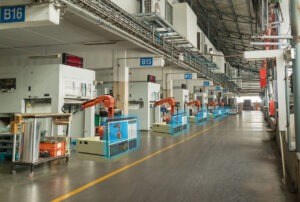The next era of industry will require an experience that lives up to the technology. Enter XR or “Extended Reality,” the merging of real and virtual worlds ranging from augmented to virtual reality that has been inching closer to everyday human activity for several years. And now as physical and digital worlds merge, sea changes are also afoot in the realm of manufacturing. We are witnessing the emergence of Industry 4.0.
So what exactly is Industry 4.0? According to Wikipedia, it’s “the ongoing automation of traditional manufacturing and industrial practices, using modern smart technology.” Succinct but not the full story.
Deloitte’s definition is much more prophetic: “Industry 4.0 encompasses a promise of a new industrial revolution—one that marries advanced manufacturing techniques with the Internet of Things to create manufacturing systems that are not only interconnected, but communicate, analyze, and use information to drive further intelligent action back in the physical world.”
In other words, Industry 4.0 is a pretty big deal. It will change the skills we need, the insights from big data we have to work with, and the level to which we will produce. The stars of the show will be several key digitalization technologies we will need to integrate. These include predictive analytics, autonomous robotics, IoT (Internet of Things), AI (Artificial Intelligence), and additive manufacturing.

The Challenge of Increased Complexity
As impressive as the technology is, it also brings with it an unprecedented level of complexity. Not only are products and processes becoming more complex, so are all aspects of the manufacturing ecosystem. And it’s leaving workers behind.
In the current context, workers are disengaged and underskilled. The result is reduced worker attention, safety concerns, and polarization between workers of different generations. People and companies suffer without a cohesive shared purpose.
In fact, a recent Deloitte/Manufacturing Institute study suggested that industries are entering a period of acute long-term labor shortages. They are predicting that there will be 2.4 million unfilled manufacturing jobs by 2028.
Some barriers to success include the inherent flaws in using tablets and smartphones as the primary devices on the factory floor. Both of these form factors compromise situational awareness. Meanwhile, data analysts are hunkered down in the backroom on desktops far from the real time context of production as well.
Antiquated user interface is another major issue. A bad U.I. reduces productivity, leaving workers disengaged and uninspired.
The Human Factor
In order to fully integrate new technology, we’ll need to blend the physical and digital worlds in a way that aligns with natural human behavior. Enter XR or “Extended Reality.”
The right human-machine interaction will enable impactful data-driven decisions that produce smarter, more competitive services. Human machine interface (HMI) technology will connect people and devices. Connected wearable devices help workers perform functions faster and more accurately.
There will be a convergence of the smartphone, mobile VR headset, and AR glasses into a single device. XR wearables will probably become one of the world’s most disruptive computing platforms since the smartphone.
As automation and customization increases across the supply chain, VR and AR solutions will ensure that production and processes can be managed and improved in real-time by human intelligence.
Extended reality has the potential to empower employees, transform operations, and better serve customers and it will bring a welcome challenge of finding the ideal way to create and present an immersive experience to the user.
Picture This
Here are a few ways XR will impact the factory of tomorrow:
- Head mounted displays free hands and attention to focus on primary tasks increasing safety and efficiency.
- Remote collaboration allows off-site specialists and cross-border teams to work with local technicians.
- Managers can quickly survey operations across an entire facility to find bottlenecks.
- QR codes make it easy to access data and analytics in context.
- Voice-driven data entry as well as photo and video capture make compliance a breeze.
- Immersive learning mirror real life situations which reduces costs, increases retention and captures valuable insights to fuel improvements.
- Designers and engineers use VR simulations that reduce design cycle time, make for faster prototyping and lower costs.
- Additive technology will allow for unprecedented customization.
The XR Industry 4.0 Webinar
XR is a transformative technology. It’s already changing the way people work and will continue to accelerate. Learn more about the part XR will play in Industry 4.0 in our our detailed webinar led by BLDG25 SVP of Client Experience, Chris Haire: “Why XR is the Secret Ingredient to Industry 4.0.” and contact us to learn how we can help your manufacturing processes become an immersive and impactful experience for your teams.
